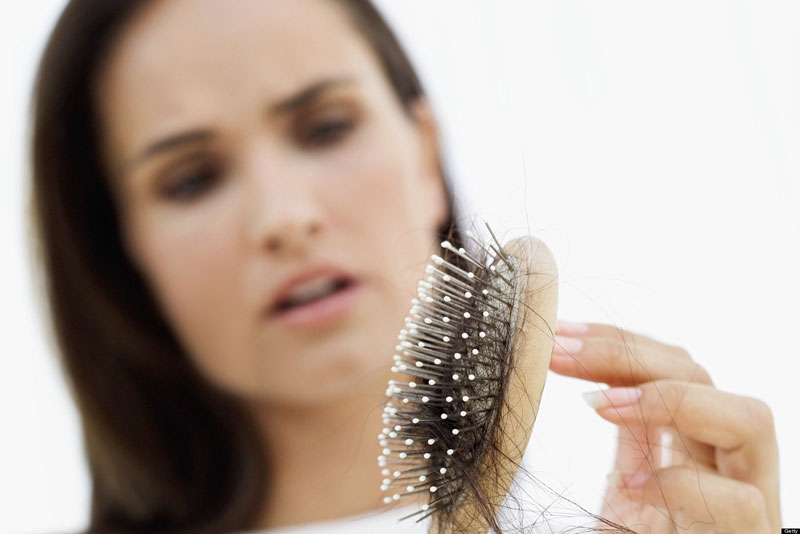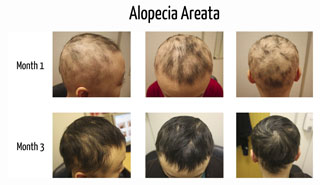 ‘Alopecia’ is a word used to describe hair loss. ‘Areata’ means ’round’. Alopecia areata is a relatively common auto-immune condition affecting the scalp and body hair. There are four main sub-types described:
‘Alopecia’ is a word used to describe hair loss. ‘Areata’ means ’round’. Alopecia areata is a relatively common auto-immune condition affecting the scalp and body hair. There are four main sub-types described:
1. Alopecia areata – Round, bald patches tend to appear initially in the scalp. The patches are smooth and can have fine white central hairs. They tend to be scattered in an asymmetrical manner over the scalp. As this type of hair loss is asymptomatic, it is often incidentally discovered by a barber or hairdresser who finds the bald patch hidden beneath the rest of the hair.
2. Alopecia totalis – 5% of patients with alopecia areata may go on to lose all their scalp hair.
3. Alopecia universalis – The entire body hair is affected. This affects only 1% of patients with alopecia areata.
4. Alopecia areata incognita – The patient presents with sudden diffuse thinning of the scalp hair. The condition may be confused with telogen effluvium, which presents in a similar way.
Causes of Alopecia Areata
 Alopecia areata is an auto-immune condition where the immune cells that are designed to fight infection attack normal tissue, in this case, a person’s normal hair cells. Special white cells called lymphocytes, cluster around the hair follicles and release chemical messengers called cytokines. The hair follicle is thus damaged and the hair falls out. This form of alopecia is fortunately non-scarring and reversible.
Alopecia areata is an auto-immune condition where the immune cells that are designed to fight infection attack normal tissue, in this case, a person’s normal hair cells. Special white cells called lymphocytes, cluster around the hair follicles and release chemical messengers called cytokines. The hair follicle is thus damaged and the hair falls out. This form of alopecia is fortunately non-scarring and reversible.
Auto-immune diseases may run in families. Individuals may also have a cluster of associated auto-immune conditions. These include white patches on the skin called vitiligo, Type 1 diabetes mellitus, pernicious anaemia and lupus erythematosus.
It is well recognised that stress alters immune system function. A significant stressful episode may precipitate alopecia areata in someone who is predisposed to the condition. These triggers may be either physical or emotional stressors. To compound this, alopecia areata itself may be emotionally very distressing.
Predictors for more Severe Disease
- Down Syndrome
- Rapid onset
- Childhood onset of disease
- An ophiasis pattern (around the back of the head)
- A history of allergy or atopy
Natural History of Alopecia Areata
Alopecia areata has three main stages. First, there is sudden loss of hair, usually from the scalp. The patches of hair loss then slowly enlarge. There may be a few broken or tapered hairs within the bald patches. Lastly new hair grows back, often initially coloured white or grey. It may take months and sometimes years to regrow all the hair. One patch can be falling out while another is regrowing. Once a person has had an episode of alopecia, the chance of a repeat episode is relatively high.
Although the scalp is the most common affected area, any hair-bearing area can be involved, including the eyebrows, eyelashes, beard and body areas.
Treatment of Alopecia Areata
Alopecia areata is not an easy condition to treat. Methods are employed to either dampen the immune system locally or generally. Some contact-sensitisers are used to confuse the immune system, hence encouraging hair growth by diverting the white blood cells away from the hair follicle. Fortunately, the hair commonly grows back by itself. The new hair may be initially white, but will re-colour with time.
One of the most reliable treatments for smaller patches of hair loss is the local injection of corticosteroids. This will encourage the hair to grow at that site. It will not prevent other patches from forming. If more patches do form, then further intralesional corticosteroids may be used.
Other treatments include the use of topical hair-stimulating agents such as minoxidil, or irritants/allergens such as anthralin or DCP. These treatments do not work in all cases. Treatment response may also be temporary. The more severe the alopecia, the less likely the hair will respond to these treatments.
Widespread alopecia may be managed with oral immune suppressive medication. The pros and cons of these medications need to be carefully weighed up before embarking on these therapies.
Camouflaging hair loss
False eyebrows, eyelashes and wigs are all effective ways of camouflaging alopecia. The ENT Wellbeing website has a nice article on this topic.
If you have any questions or concerns about alopecia areata contact your local doctor, who will arrange for you to see a dermatologist. Contact us today.


